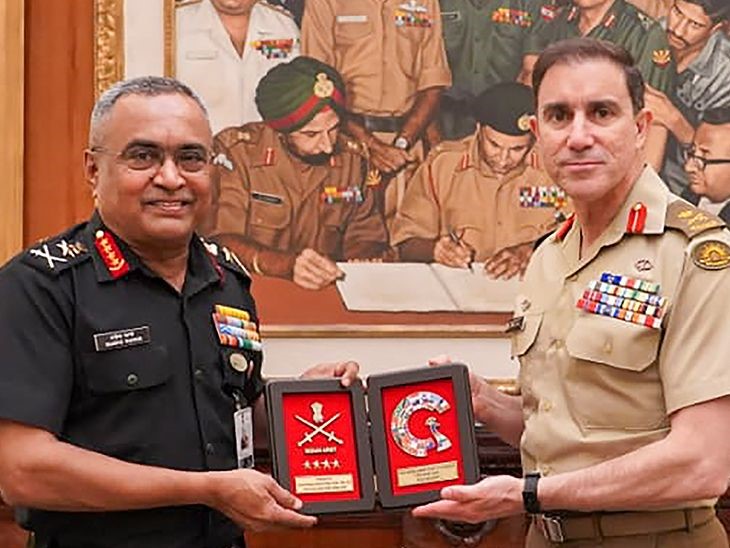Description

Disclaimer: Copyright infringement not intended.
Context
- India stands for a free, open, inclusive & rules-based Indo-Pacific - the Defence Minister said at the 13th Indo-Pacific Armies Chiefs’ Conference in New Delhi.
Indo-Pacific Armies Chiefs’ Conference
About
- The Indian Army and the United States Army are co-hosting 13th IPACC, Indo-Pacific Armies Management Seminar (IPAMS) and Senior Enlisted Leaders Forum (SELF) -- a three-day conference of Chiefs of Armies and delegates of 35 countries in New Delhi from September 25th to 27th, 2023.
Theme
- The central theme for this forum is ‘Together for Peace: Sustaining Peace and Stability in the Indo-Pacific Region.’
Significance
- The conference will provide an opportunity for Army Chiefs and senior-level leaders from land forces, primarily of the Indo-Pacific region, to exchange ideas and views on security and contemporary issues.
- The core effort of the forum will be to promote peace and stability in the Indo-Pacific region through mutual understanding, dialogue, and friendship amongst the littoral partners.

Highlights of the 13th IPACC
Central Message of 13th IPACC
- There is a need for collective wisdom and concerted efforts to deal with the complexities of the Indo-Pacific Region.
- This is necessary for tapping its full potential, to ensure a future marked by prosperity, security & and inclusivity.
- These are in consonance with the ancient Indian ethos of ‘Vasudhaiva Kutumbakam’ (The World is One Family) and the G-20 motto ‘One Earth, One Family, One Future’.
Importance of Indo-Pacific
- The Indo-Pacific is no more a maritime construct, but a full-fledged geo-strategic construct, and the region is facing a complex web of security challenges, including boundary disputes & and piracy.
Analogy: ‘Circle of Concern’ and ‘Circle of Influence’
- The Geo-Strategic Importance of the Indo-Pacific can be explained through a theoretical model by American author and speaker Mr Stephen R. Covey, which is based on two circles – ‘Circle of Concern' and ‘Circle of Influence’.
-
- The ‘Circle of Concern’ encompasses everything one cares about, including things that can be controlled and things that cannot. It includes a wide range of external factors & issues such as global events, economic conditions, other people's opinions, weather and many other aspects of life.
- The ‘Circle of Influence’ comprises things over which one has direct control or can exert some degree of influence. It may involve your attitudes, behaviors, decisions, relationships, and actions.
- There may be instances when the ‘circles of concern’ of different nations overlap with each other. International maritime trade routes passing through high seas, beyond the Exclusive Economic Zones of any country, are relevant examples.
- This can either result in conflict between nations or they can decide to coexist by mutually deciding the rules of engagement. The concept of these circles underscores the importance of strategic thinking and prioritisation.
Importance of Collaboration
- States must recognize that global issues involve multiple stakeholders and no one country can address these challenges in isolation.
- There is a need to engage with the broader international community and work collaboratively through diplomacy, international organizations, and treaties to tackle common concerns within the overlapping ‘Circles of Concern’.
- The United Nations Convention on the Law of the Sea (UNCLOS), 1982 is a good example of such an international agreement that establishes the legal framework for maritime activities and addresses the issues arising from overlapping ‘circles of concern’ of different nations.
Need for expansion
- States must identify and seek to expand their ‘Circle of Influence’ to promote national interests on the global stage.
- States must involve building partnerships, participating in regional organizations, and employing diplomatic, economic, or military tools strategically.
- This conference is an exercise where we all are trying to expand our ‘Circles of Influence’ while harmonising the overlaps of our ‘circles of concern’.
India’s Commitment and Vision
- India stands for a free, open, inclusive and rules-based Indo-Pacific Region in the pursuit of shared security and prosperity.
- ‘Neighbourhood First’ is the cornerstone of India’s culture since time immemorial.
- India’s approach to the region is defined by its ‘Act East Policy’.
- “Our engagement in the Indo-Pacific is based on five 'S’: Sammaan (Respect); Samvad (Dialogue); Sahyog (Co-operation); Shanti (Peace) and Samridhi (Prosperity).
- India's efforts towards building robust military partnerships with friendly countries underscore its commitment to not only safeguard national interests but also address global challenges faced by all.
- On climate change, one of the gravest global challenges, India stated that the Indian Armed Forces, with their unwavering dedication and professionalism, are the first responders in disaster situations and contribute to humanitarian assistance and disaster relief (HADR) efforts.
.jpg)
Significance
- The IPACC, Indo-Pacific Armies Management Seminar (IPAMS), and Senior Enlisted Leaders Forum (SELF) are one of the largest brainstorming events of land forces in the region.
- These events provide a unique opportunity to build common perspectives towards a shared vision and build & strengthen partnerships in the spirit of collaborative security for all.
|
PRACTICE QUESTION
Q. India stands for a free, open, inclusive, and rules-based Indo-Pacific Region in the pursuit of shared security and prosperity. India's efforts towards building robust military partnerships with friendly countries underscore its commitment to not only safeguard national interests but also address global challenges faced by all. Elucidate.
|












